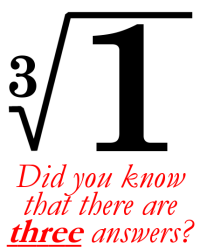Category Archives: Math
 Earlier this year, I posted about that math gag that seems to prove (very mathematically) that 2=0 (an alternate version “proves” 1=0 using the same trick: a covert division by zero, an operation whose undefined result breaks the chain of logic).
Earlier this year, I posted about that math gag that seems to prove (very mathematically) that 2=0 (an alternate version “proves” 1=0 using the same trick: a covert division by zero, an operation whose undefined result breaks the chain of logic).
Today I’m posting about another somewhat common mathematical (or rather, geometrical) gag — one involving chocolate! In the form of a magical chocolate bar that lets us remove an infinite number of bite-sized pieces but somehow remains the same size. It seems impossible.
And of course, it is. In this post I reveal the magician’s trick!
Continue reading
21 Comments | tags: chocolate, fun with numbers, geometry, old tricks, triangle, tricks | posted in Math
 Thinking back on your math classes, you may recall that the square root of a number has two answers, one positive and one negative. For example, the square root of +9 is both +3 and -3 (the first one is known as the principal square root). Squaring +3 gives you +9, of course, but so does squaring -3.
Thinking back on your math classes, you may recall that the square root of a number has two answers, one positive and one negative. For example, the square root of +9 is both +3 and -3 (the first one is known as the principal square root). Squaring +3 gives you +9, of course, but so does squaring -3.
Square roots aren’t the only roots of a number. For example, the (principal) cube root of +8 is +2 because +2³ = +2 × +2 × +2 = +8.
But just as square roots have two answers, cube roots have three (and fourth roots have four and so on and so on).
Continue reading
3 Comments | tags: complex numbers, complex plane, cube roots, Euler's Formula | posted in Brain Bubble, Math
 Today (3/14) is Pi Day. People everywhere (or at least math geeks everywhere) are baking decorated pies (or cakes or cookies) to celebrate. And while this is yet another math-y post, it’s not about pi. I’m more of a tau guy, anyway, so I celebrate Tau Day (6/28), because I get twice the (pizza) pie.
Today (3/14) is Pi Day. People everywhere (or at least math geeks everywhere) are baking decorated pies (or cakes or cookies) to celebrate. And while this is yet another math-y post, it’s not about pi. I’m more of a tau guy, anyway, so I celebrate Tau Day (6/28), because I get twice the (pizza) pie.
Today is also Albert Einstein’s birthday, which I’ve always thought was a cool coincidence. He’s 145 now (and still being widely misquoted).
But this post isn’t about him either.
Continue reading
10 Comments | tags: Albert Einstein, pi day, tau day, trigonometry, two slit experiment | posted in Brain Bubble, Math
 Consider the lowly square, a four-sided shape with sides of equal length meeting at right angles. The embodiment of what we’re referring to when we refer to square miles, square kilometers, square inches, or square whatevers. The two-dimensional version of any one-dimensional length.
Consider the lowly square, a four-sided shape with sides of equal length meeting at right angles. The embodiment of what we’re referring to when we refer to square miles, square kilometers, square inches, or square whatevers. The two-dimensional version of any one-dimensional length.
A trivially easy shape to draw, all you need is a straight edge and a compass — the latter for ensuring your corners are right angles (see Plato’s Divided Line for more on using a straight edge and compass). The only simpler shape is the circle.
Yet the simple square threw early mathematicians into a serious tizzy!
Continue reading
12 Comments | tags: irrational numbers, Pythagoras, square | posted in Brain Bubble, Math
 You may have, at some point, seen one of those bits where a series of seemingly simple math operations somehow end up proving that 1=0 or something equally clearly wrong. Most of them accomplish their joke by sneaking in a hidden division by zero. From that point on, all bets are off (see Divide by Zero).
You may have, at some point, seen one of those bits where a series of seemingly simple math operations somehow end up proving that 1=0 or something equally clearly wrong. Most of them accomplish their joke by sneaking in a hidden division by zero. From that point on, all bets are off (see Divide by Zero).
Recently, on a YouTube channel I follow, I saw a clever example that uses a much sneakier trick. It’s harder to spot because the operation it uses is legit in two of the three possible cases.
The gag, of course, uses the third one.
Continue reading
7 Comments | tags: fun with numbers, imaginary unit, numbers | posted in Brain Bubble, Math
 You may remember learning way back in grade school that you can’t divide by zero. You may remember being told that division by zero is undefined. But have you ever wondered why we can’t divide by zero? Couldn’t the answer just be zero? We get zero when we multiply by zero, so why not when we divide?
You may remember learning way back in grade school that you can’t divide by zero. You may remember being told that division by zero is undefined. But have you ever wondered why we can’t divide by zero? Couldn’t the answer just be zero? We get zero when we multiply by zero, so why not when we divide?
But dividing is the opposite (or inverse) of multiplying, so if multiplying by zero gives zero, then maybe dividing by zero gives us… infinity? But infinity isn’t a number (it’s an idea), so that doesn’t work, either.
In this post I’ll dig into why division by zero is undefined.
Continue reading
4 Comments | tags: division, fractions, zero | posted in Basics, Math, Sideband

nx vs xn vs nx (for n=42)
You’ve probably heard the phrase “exponential growth” in reference to something that grows very fast. A common example is bacteria in a petri dish. More relevant in daily life, perhaps, the spread of a highly communicable disease or a “viral” meme. These things all can have exponential growth.
You may also have heard the phrase “geometric growth” and wondered how — if at all — it differs from the exponential form. Recently I found myself curious enough about the difference to dig into it a little and find out once and for all.
This post records my simple exploration.
Continue reading
2 Comments | tags: exponential function, geometric function, linear function | posted in Math, Sideband
 This is one of those geeky posts more a “Dear Diary” (or “Dear Lab Notebook”) entry than a post I expect anyone anywhere will get anything out of. This — in part — is about how we define numbers using set theory, so it’s pretty niche and rarified. Tuning out is understandable; this is extra-credit reading.
This is one of those geeky posts more a “Dear Diary” (or “Dear Lab Notebook”) entry than a post I expect anyone anywhere will get anything out of. This — in part — is about how we define numbers using set theory, so it’s pretty niche and rarified. Tuning out is understandable; this is extra-credit reading.
This is also about having a double-lightbulb moment. I finally get why what always seemed an overly complicated approach is actually perfect. A smaller lightbulb involves easily solving a programming problem that confounded me previously.
Fun for me, but your mileage may vary.
Continue reading
3 Comments | tags: computer code, math theory, natural numbers, set theory | posted in Brain Bubble, Math
 Or do I mean Logic Square? Because it works either way. The Logic Square (or Square Logic) in question is a logic game created by Charles Lutwidge Dodgson (1832-1898) and introduced in his 1896 book Symbolic Logic Part I (a second part was published posthumously).
Or do I mean Logic Square? Because it works either way. The Logic Square (or Square Logic) in question is a logic game created by Charles Lutwidge Dodgson (1832-1898) and introduced in his 1896 book Symbolic Logic Part I (a second part was published posthumously).
Dodgson was a capable mathematician, but most probably know him by his penname, Lewis Carroll, under which he wrote poetic fantasy fiction about a girl who goes on wild adventures.
But this is about his logic game. It’s like a square Venn diagram with game pieces.
Continue reading
5 Comments | tags: boolean logic, four-square, Lewis Carroll, logic, logic games, Venn diagram | posted in Basics, Math
 It’s been a while, but the two previous posts in this series (this one and this one) explored the mechanism behind partial differential equations that equate the time derivative (the rate of change), with the second spatial derivative (the field curvature). The result pulls exceptions to the average back to the average in proportion to how exceptional they are.
It’s been a while, but the two previous posts in this series (this one and this one) explored the mechanism behind partial differential equations that equate the time derivative (the rate of change), with the second spatial derivative (the field curvature). The result pulls exceptions to the average back to the average in proportion to how exceptional they are.
Such equalities appear in many classical physics equations where they have clear physical meaning. Heat diffusion (explored in the previous posts) is a good example.
In quantum mechanics, they also appear in the Schrödinger Equation.
Continue reading
6 Comments | tags: QM101, quantum mechanics, Schrödinger Equation, wave-function | posted in Math, Physics
 Earlier this year, I posted about that math gag that seems to prove (very mathematically) that 2=0 (an alternate version “proves” 1=0 using the same trick: a covert division by zero, an operation whose undefined result breaks the chain of logic).
Earlier this year, I posted about that math gag that seems to prove (very mathematically) that 2=0 (an alternate version “proves” 1=0 using the same trick: a covert division by zero, an operation whose undefined result breaks the chain of logic). Thinking back on your math classes, you may recall that the
Thinking back on your math classes, you may recall that the  Today (3/14) is
Today (3/14) is  Consider the lowly
Consider the lowly 
 You may remember learning way back in grade school that you can’t divide by zero. You may remember being told that
You may remember learning way back in grade school that you can’t divide by zero. You may remember being told that 
 This is one of those geeky posts more a “Dear Diary” (or “Dear Lab Notebook”) entry than a post I expect anyone anywhere will get anything out of. This — in part — is about how we define numbers using set theory, so it’s pretty niche and rarified. Tuning out is understandable; this is extra-credit reading.
This is one of those geeky posts more a “Dear Diary” (or “Dear Lab Notebook”) entry than a post I expect anyone anywhere will get anything out of. This — in part — is about how we define numbers using set theory, so it’s pretty niche and rarified. Tuning out is understandable; this is extra-credit reading. Or do I mean Logic Square? Because it works either way. The Logic Square (or Square Logic) in question is a logic game created by
Or do I mean Logic Square? Because it works either way. The Logic Square (or Square Logic) in question is a logic game created by  It’s been a while, but the two previous posts in this series (
It’s been a while, but the two previous posts in this series (











